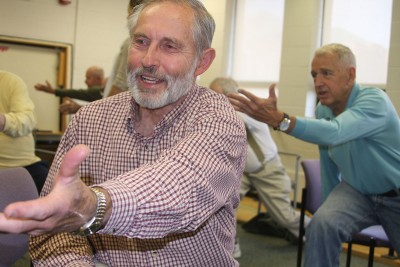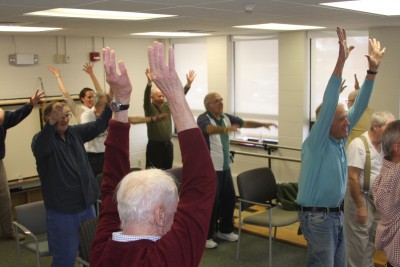
Results of a clinical study on how to best gauge whether patients with Parkinson’s disease are effectively responding to treatments will be presented by two Nayden Rehabilitation Clinic graduate students and their advisors this fall.
Overseen by Neag School of Education Department of Kinesiology clinical instructors Cristina Colon-Semenza and Laurie Devaney, and Dr. Michael Joseph, the study is the first neurological rehabilitation study conducted at the Nayden Clinic.
What makes the research so important, Colon-Semenza said, is that its goal is not just to provide rehab clinicians with better tools to assess Parkinson’s patients’ progress, but to help ensure Parkinson’s patients are living with the highest-possible quality of life.
“Parkinson’s is a tricky disease in that not all people respond to medications in the same way, and most need very individualized treatments,” said Colon-Semenza, who also founded and oversees the Nayden Clinic’s weekly Exercise Group for People with Parkinson’s disease. “Determining what tests and measures can most effectively gauge a patient’s mobility will, in turn, help clinicians provide the most effective treatments.”

Approximately 40 patients of varying ages, and representing a diverse range of cultures and disease progression, participated in the study, which examined the reliability of measuring gait speed in people with Parkinson’s disease with a 10 Meter Walking Test. Doing most of the hands-on work to gather the needed data and log participants’ walking speed were Doctor of Physical Therapy students Jesse Lang and Thomas Kassan. The research group has determined that the 10 Meter Walk Test is a reliable tool for assessing gait speed in people with Parkinson’s disease. In addition, the Minimal Detectable Change, a measure that determines change not due to error, was determined for gait velocity and step frequency.
The study illustrates the Nayden’s Clinic commitment to not just providing the best possible rehabilitative care, but advancing it. Results were presented recently at the Connecticut Physical Therapy Association’s annual Fall conference and will be presented to alumni, faculty and peers later this fall. Colon-Semenza said: “We’re hoping this will be the first of many neurological rehabilitation studies coming out of the clinic.”
She’s also hoping news of the study will help shine a light on the services the Nayden Clinic provides Parkinson’s patients, which include an exercise group that meets Fridays from 12-1pm. A board-certified neurologic clinical specialist, Colon-Semenza also recently underwent the needed training to become certified in the Lee Silverman Voice Training BIG program that has provided Parkinson’s patients intense amplitude based physical therapy with impressive improvements in function and balance after a short period of rehabilitation.
“Exercise and physical rehabilitation are the big focus of what we do at the Nayden Center, but I’ve also watched real friendships and camaraderie form between our Parkinson’s patients, which helps battle the depression and isolation that can come along with this disease,” she added. “The best care is always holistic care—care that treats body, mind and spirit. It’s exciting for me to see us doing so much for people with Parkinson’s disease, who too often aren’t able to access the wide range of services they need. The services the Nayden Clinic offers, coupled with this new study, have the potential to offer Parkinson’s patients a chance for remarkable improvements.”
 Facebook
Facebook
 Twitter
Twitter
 LinkedIn
LinkedIn
